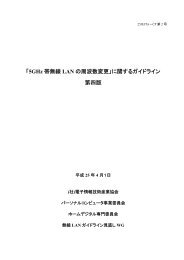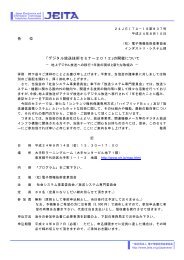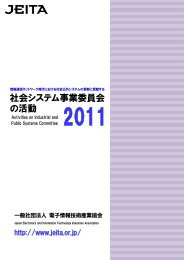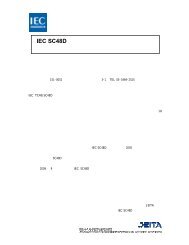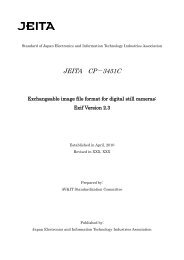Guidelines for Standardization of Material Declaration - JEITA
Guidelines for Standardization of Material Declaration - JEITA
Guidelines for Standardization of Material Declaration - JEITA
You also want an ePaper? Increase the reach of your titles
YUMPU automatically turns print PDFs into web optimized ePapers that Google loves.
July 22, 2003<br />
Japan Green Procurement Survey <strong>Standardization</strong> Initiative<br />
<strong>Guidelines</strong> <strong>for</strong> <strong>Standardization</strong> <strong>of</strong> <strong>Material</strong> <strong>Declaration</strong><br />
These guidelines indicate common requirements <strong>for</strong> companies that implement green<br />
procurement surveys. Issuance <strong>of</strong> the guidelines aims to reduce the burden on suppliers<br />
(hereinafter referred to as “surveyed companies”) involved in green procurement surveys<br />
and to improve the accuracy <strong>of</strong> the answers they provide.<br />
1. Basic Points<br />
1) The <strong>Guidelines</strong> <strong>for</strong> <strong>Standardization</strong> <strong>of</strong> <strong>Material</strong> <strong>Declaration</strong> apply to the<br />
“Green Procurement Survey” related to chemical substances mainly<br />
contained in electric and electronic appliances and their parts and materials.<br />
2) These guidelines deal with the “Chemical Substance Survey,” the “Chemical<br />
Substance Survey,” and the “Survey Response Format.”<br />
3) These guidelines were developed by the Japan Green Procurement Survey<br />
<strong>Standardization</strong> Initiative (hereinafter referred to as “JGPSSI”), and the<br />
rights belong to JGPSSI.<br />
4) The guidelines can also be freely used by non-participating companies.<br />
5) The guidelines shall be published in both English and Japanese. When<br />
guidelines in other languages are needed, surveying companies who need<br />
them will create them If there is some difference between the Japanese<br />
version and the English version, the Japanese version is prioritized.<br />
2. Operation <strong>of</strong> the <strong>Guidelines</strong><br />
1) Operation <strong>of</strong> the <strong>Guidelines</strong> may start from July X, 2003. The old lists<br />
(guidelines 2003.1.9) can be used till the last day <strong>of</strong> March, 2004.<br />
Surveying companies will individually decide when specifically to implement<br />
and launch the operation, taking into consideration the amount <strong>of</strong><br />
preparation needed. When starting the operation, surveying companies<br />
should thoroughly provide the needed in<strong>for</strong>mation to their related companies<br />
in advance, so that the operation can get underway smoothly.<br />
2) JGPSSI will revise the guidelines, taking trends <strong>of</strong> international<br />
standardization and opinions from surveyed companies into consideration<br />
with the approval by member companies.<br />
3) As a rule, use the operation manual to operate the survey.<br />
1
3. Basic In<strong>for</strong>mation Survey<br />
1) The purpose <strong>of</strong> conducting the “Basic In<strong>for</strong>mation Survey” is to identify the<br />
parts and materials to be surveyed. This survey can be carried out based on<br />
Appendix 1.<br />
2) Each surveying company will decide whether to ask surveyed companies <strong>for</strong><br />
their impresses or signatures.<br />
3) As a rule, the “Survey <strong>of</strong> Chemical Substances Used in Manufacturing<br />
Processes” is <strong>for</strong> surveying whether ozone depleting substances (listed in<br />
Appendix 6) are used or not. This survey also applies to products surveyed<br />
companies procured, and to the end <strong>of</strong> their supply chains.<br />
4. Chemical Substance Survey<br />
1) The survey items on the “Chemical Substance Survey” are: (1) whether the<br />
listed substances are contained; (2) their content; (3) in which parts they are<br />
used; and (4) the purposes <strong>of</strong> using them. These four items are the ones used<br />
in common by all companies. It is up to each surveying company to add other<br />
requirements.<br />
2) The Chemical Substance Survey shall be carried out based on the substance<br />
groups listed in List A (Appendix 2-1,2-2), as a rule.<br />
3) It is up to each surveying company to add chemical substances to List A.<br />
However, when adding, surveying companies should clarify the purposes <strong>of</strong><br />
doing so <strong>for</strong> surveyed companies. Surveying companies can, at their option,<br />
submit the new lists to JGPSSI.<br />
4) Management ranking can be set by the respective surveying companies if<br />
necessary.<br />
5) The list <strong>of</strong> substances on the substance levels <strong>for</strong> List A will be called a<br />
“Common List <strong>of</strong> Breakdown Substances,” and it will be shared among<br />
surveying companies. (Appendix 3).<br />
6) The survey shall be carried out on a substance group level based on List A, as<br />
a rule. However, it is possible to oblige surveyed companies to provide<br />
answers down to the level <strong>of</strong> breakdown substances based on Appendix 4, if<br />
surveying companies decide to do so.<br />
7) Surveying companies should ask surveyed companies to answer about<br />
“content,” regardless <strong>of</strong> the content or content ratio, as long as the listed<br />
substances have been intentionally added. Known content or content ratio<br />
data, such as impurities, should also be provided.<br />
8) Revisions <strong>of</strong> List A and the Common List <strong>of</strong> Breakdown Substances will be<br />
done by JGPSSI.<br />
2
Appendix- 2-1 List A July 22, 2003<br />
Level A<br />
*:The substance groups <strong>of</strong> Level A are those subject to currently enacted legislations that prohibit or restrict their use in products or marketing<br />
them or require reporting.<br />
*:Although the level A chemical substance groups are selected according to such laws and regulations, compliance <strong>of</strong> them is not to be assured.<br />
No. Substance Group Classification Substance applicable laws and regulations<br />
1 A05 Cadmium and Cadmium Compounds<br />
2 A07 Hexavalent Chromium Compounds<br />
Metal Compounds *1 Halogenated organic componds<br />
Others<br />
3 A09 Lead and Lead Compounds<br />
4 A10 Mercury and Mercury Compounds<br />
Statutory order No.1199 <strong>of</strong> December 23, 1992 on the prohibition <strong>of</strong> sale, import and<br />
manufacture <strong>of</strong> cadmium--containing products,<br />
76/769/EEC(+91/338/EEC),<br />
91/157/EEC・93/86/EEC,<br />
2000/53/EC(EU/ELV),<br />
2002/95/EC(EU/RoHS),<br />
94/62/EEC,<br />
Model Toxics in Packaging<br />
2000/53/EC(EU/ELV),<br />
2002/95/EC(EU/RoHS),<br />
94/62/EEC,<br />
Model Toxics in Packaging<br />
76/769/EEC(+86/677/EEC),<br />
91/157/EEC・93/86/EEC,<br />
2000/53/EC(EU/ELV),<br />
2002/95/EC(EU/RoHS),<br />
94/62/EEC,<br />
Model Toxics in Packaging<br />
76/769/EEC,<br />
91/157/EEC (+98/101/EC),<br />
2000/53/EC(EU/ELV),<br />
2002/95/EC(EU/RoHS),<br />
94/62/EEC、Model Toxics in Packaging<br />
5 A17 Tributyl Tin Oxide (TBTO)<br />
The law concerning the examination and regulation <strong>of</strong> manufacture etc. <strong>of</strong> chemical<br />
substances(class 1 specified chemical substances)<br />
6 A18 Tributyl Tins & Triphenyl Tins<br />
The law concerning the examination and regulation <strong>of</strong> manufacture etc. <strong>of</strong> chemical<br />
substances(class 2 specified chemical substances)<br />
7 B02 Polybrominated Biphenyls (PBBs) 2002/95/EC(EU/RoHS)、(Dioxin Decree 07/15/1994)<br />
8 B03 Polybrominated Diphenyl ethers (PBDEs)<br />
2002/95/EC(EU/RoHS),<br />
(Dioxin Decree 07/15/1994)pentaBDE,<br />
octaBDE 76/769/EEC(+2003/11/EC)<br />
The law concerning the examination and regulation <strong>of</strong> manufacture etc. <strong>of</strong> chemical<br />
9 B05 Polychlorinated Biphenyls (PCBs)<br />
substances(class 1 specified chemical substances),<br />
76/769/EEC<br />
10 B06 Polychloronapthalenes (Cl=>3)<br />
The law concerning the examination and regulation <strong>of</strong> manufacture etc. <strong>of</strong> chemical<br />
substances(class 1 specified chemical substances)<br />
11 B09 Short Chain Chlorinated Paraffins *2<br />
76/769/EEC(+2002/45/EC),<br />
(Dioxin Decree 07/15/1994)<br />
12 C01 Asbestos 76/769/EEC(+91/659/EEC)<br />
13 C02 Azo Colorants *3<br />
76/769/EEC(+2002/61/EC・+2003/3/EC),<br />
Consumer Goods Ordinance(04/1997)<br />
Law Concerning The Protection <strong>of</strong> The Ozone Layer Through The Control <strong>of</strong> Specified<br />
Substances and Other Measures,<br />
14 C04 Ozone Depleting Substances *4<br />
Montreal Protocol,<br />
Section 611 on the Clean Air Act <strong>of</strong> 1990,<br />
76/769/EEC(+94/60/EEC,+97/64/EEC)<br />
15 C06 Radioactive Substances<br />
Law <strong>for</strong> the Regulation <strong>of</strong> Nuclear Source <strong>Material</strong>,<br />
Fuel <strong>Material</strong> Reactors 1986<br />
*1:Inculding alloyed metal.<br />
*2:Short Chain Chlorinated Paraffins(C10-13).<br />
*3:Azo dyes and pigment <strong>for</strong>ming certain amines. The subjected applications are limited to parts that may come into direct contact with human skin <strong>for</strong> a long time.<br />
(certain amines are the substances listed 76/769/EEC,the 19th Amendment, refer to Appendix 3-1.)<br />
*4:Substances listed in the Montreal Protocol, refer to Appendix3-1<strong>for</strong> the details <strong>of</strong> classes.<br />
Regarding the ClassⅡsubstances, although they are not prohibited substances, the survey <strong>for</strong> them should be carried out.<br />
(C) Copyright by the Japan Green Procurement Survey <strong>Standardization</strong> Initiative<br />
5
Appendix-3 The Common List <strong>of</strong> Breakdown Substances July 22, 2003<br />
* CAS No, chemical <strong>for</strong>mula and metals' conversion factors <strong>of</strong> these substances might have mistakes, thus the content is not assured<br />
Classification No. Substance Group No. Substance<br />
Chemical<br />
Formula<br />
Metal<br />
conversio<br />
n factor<br />
CAS No.<br />
Level A<br />
Metal A05 Cadmium and its compounds A05001 Cadmium Cd 1.000 7440-43-9<br />
compounds A05002 Cadmium oxide CdO 0.875 1306-19-0<br />
A05003 Cadmium sulfide CdS 0.778 1306-23-6<br />
A05004 Cadmium chloride CdCl2 0.613 10108-64-2<br />
A05005 Cadmium sulfate CdSO4 0.539 10124-36-4<br />
A05990~9 Other cadmium compounds - - -<br />
A07 Hexavalent Chromium A07001 Sodium dichromate Na2Cr2O7 0.397 10588-01-9<br />
compounds A07002 Chromium(VI) oxide CrO3 0.520 1333-82-0<br />
A07003 Calcium chromate CaCrO4 0.333 13765-19-0<br />
A07004 Lead(II) chromate PbCrO4 0.161 7758-97-6<br />
A07005 Potassium dichromate K2Cr2O7 0.353 7778-50-9<br />
A07006 Potassium chromate K2CrO4 0.268 7789-00-6<br />
A07990~9 Other hexavalent chromium compounds - - -<br />
A09 Lead and its compounds A09001 Lead Pb 1.000 7439-92-1<br />
A09002 Lead(II) carbonate PbCO3 0.775 598-63-0<br />
A09003 Lead(IV) oxide PbO2 0.866 1309-60-0<br />
A09004 Lead(II,IV) oxide Pb3O4 0.907 1314-41-6<br />
A09005 Lead(II) sulfide PbS 0.866 1314-87-0<br />
A09006 Lead(II) oxide PbO 0.928 1317-36-8<br />
A09007 Lead(II) carbonate basic 2PbCO3.Pb(OH) 2 0.801 1319-46-6<br />
A09008 Lead hydroxidcarbonate 2PbCO3.Pb(OH) 2 0.801 1344-36-1<br />
A09009 Lead(II) sulfate PbSO4 0.683 7446-14-2<br />
A09010 Lead(II) phosphate Pb3(PO4) 2 0.766 7446-27-7<br />
A09011 Lead(II) chromate PbCrO4 0.641 7758-97-6<br />
A09012 Lead(II) titanate PbTiO3 0.686 12060-00-3<br />
A09013 Lead sulfate,sulphuric acid, lead salt PbXSO4 1.000 15739-80-7<br />
A09014 Lead sulphate,tribasic PbSO4.H2O 0.850 12202-17-4<br />
A09015 Lead stearate Pb(C17H35COO) 2 0.268 1072-35-1<br />
A09016 Lead stearate,dibasic<br />
2PbO・<br />
Pb(C17H35COO) 2<br />
0.410 56189-09-4<br />
A09990~9 Other lead compounds - - -<br />
A10 Mercury and its compounds A10001 Mercury Hg 1.000 7439-97-6<br />
A10002 Mercury(II) chloride HgCl2 0.739 7487-94-7<br />
A10003 Mercury(II) oxide HgO 0.926 21908-53-2<br />
A10990~9 Other mercury compounds - - -<br />
A17<br />
Bis(tri-n-butyltin) oxide<br />
(TBTO)<br />
A17001 Bis(tri-n-butyltin) oxide O(Sn(C4H9) 3) 2 - 56-35-9<br />
A18 Tributyl Tins(TBTs) & A18001 Triphenyltin N,N'-dimethyldithiocarbamate (C6H5) 3Sn(CH3) 2NCS2 - 1803-12-9<br />
Triphenyl Tins(TPTs) A18002 Triphenyltin fluoride (C6H5) 3SnF - 379-52-2<br />
A18003 Triphenyltin acetate (C6H5) 3SnOCOCH3 - 900-95-8<br />
A18004 Triphenyltin chloride (C6H5) 3SnCl - 639-58-7<br />
A18005 Triphenyltin hydroxide (C6H5) 3SnOH - 76-87-9<br />
A18006 Triphenyltin fatty acid salts (C=9-11) - - 47672-31-1<br />
A18007 Triphenyltin chloroacetate (C6H5) 3SnOCOCH2Cl - 7094-94-2<br />
A18008 Tributyltin methacrylate (C4H9) 3SnC4H5O2 - 2155-70-6<br />
A18009 Bis(tributyltin) fumarate<br />
C2H2(COO) 2((C4H9) 3S<br />
- 6454-35-9<br />
A18010 Tributyltin fluoride (C4H9) 3SnF - 1983-10-4<br />
A18011<br />
Bis(tributyltin) 2,3-dibromosuccinate<br />
((C4H9) 3Sn) 2C2H2(Br) 2(<br />
- 31732-71-5<br />
n) 2<br />
COO) 2<br />
A18012 Tributyltin acetate (C4H9) 3SnOCOCH3 - 56-36-0<br />
A18013 Tributyltin laurate (C4H9) 3SnC12H23O2 - 3090-36-6<br />
A18014 Bis(tributyltin) phthalate<br />
(C6H4)(COO) 2((C4H9) 3<br />
Sn) 2<br />
- 4782-29-0<br />
A18015<br />
Copolymer <strong>of</strong> alkyl acrylate, methyl methacrylate<br />
and tributyltin methacrylate(alkyl; C=8)<br />
- - -<br />
A18016 Tributyltin sulfamate (C4H9) 3SnSO3NH2 - 6517-25-5<br />
A18017 Bis(tributyltin) maleate<br />
C2H2(COO) 2((C4H9) 3S<br />
- 14275-57-1<br />
A18018 Tributyltin chloride (C4H9) 3SnCl - 1461-22-9<br />
A18019<br />
Mixture <strong>of</strong> tributyltin cyclopentanecarboxylate and<br />
its analogs (Tributyltin naphthenate)<br />
(C4H9) 3SnCO3C5H9 - -<br />
7<br />
n) 2




